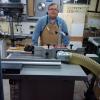I am waiting for my new Shop Fox 8" jointer to come in. Because it is 220V, I have to put in a 220V outlet in the basement. I was thinking, since I have to put in a new outlet, why not convert my Delta contractor saw from 110V to 220V ? I can pick up an extra 1/2 HP by doing this. I know I have to rewire the motor, but what about the power cord ? It is 14-3 wire. The motor draws 12.8A at 110V and 8.6 on 220V. Do I have to replace it or can I just cut the plug off and put on a new one for 220V ? TIA,
Dick




 Reply With Quote
Reply With Quote



